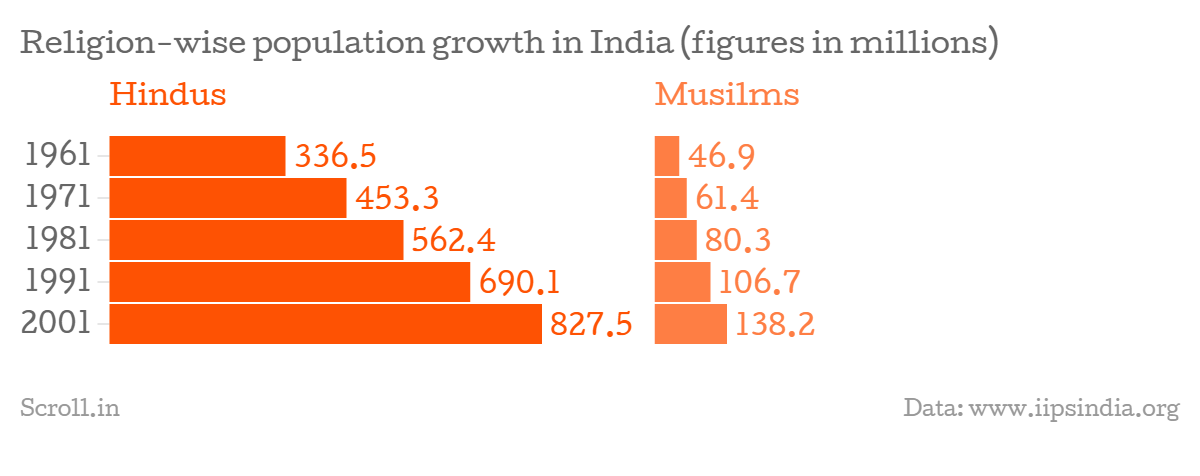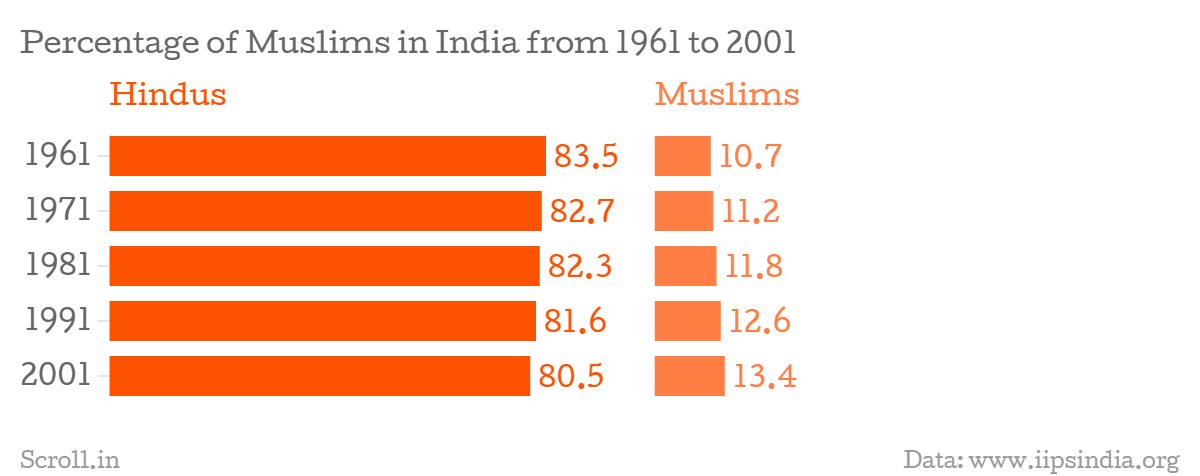Last week, Bharatiya Janata Party MP Sakshi Maharaj declared that all Hindu women should have at least four children to work for the country and promote the religion. On Tuesday, Shaymal Goswami, a BJP leader from West Bengal, reportedly went a step further, demanding that Hindu women should have at least five children to help Hinduism thrive.
The eagerness to produce more and more Hindu babies stems from the unfounded paranoia about a growth in India’s Muslim population. Outfits like the Rashtriya Swayamsevak Sangh – which has been organising conversion drives for Christians and Muslims across the country in the past month – have often peddled the theory that Hindus in India are in danger of being outnumbered by Muslims.
By way of evidence for this theory, Hindutva organisations cite census data: over the past four decades, there has been a slow increase in the population of Muslims and a slow decline in that of Hindus.
Numerically, the population of Hindus grew from 336 million in 1961 to 827 million in 2001. The Muslim population, meanwhile, grew from nearly 47 million to 138 million during the same time period. (The religious data from the 2011 census has not yet been released).
The percentage of Hindus and Muslims in relation to the total population has seen a very gradual change: in four decades, the proportion of Hindus declined by three percentage points, and that of Muslims has risen by 2.7 percentage points.
It’s just natural
To proponents of Hindutva, this three percentage point slip is reason enough to blame the minority community for producing too many children, to claim that Muslim men are waging a "love jihad" to woo Hindu women in order to convert them to Islam, and to announce the need for "homecoming" rituals. Muslims (and Christians), they claim, have been making concerted attempts to convert Hindus to Islam, so a gharwapasi is a means to restore the balance.
But demographers say that this negligible change in the composition of India's population is unconnected to the politics of conversion.
“Conversions take place in very small numbers in comparison with the huge population of this country,” said Faujdar Ram, director of the International Institute for Population Sciences in Mumbai, and co-author of a paper on religious demographics [PDF].
“The slight increase in the Muslim population over four decades is just natural, and can perhaps be attributed to more fertility in that group,” he said.
Mortality, not fertility
The image of the fertile, lower-class Muslim woman who has too many children has become almost a stereotype, but a study by Bristol University reveals that there is another, oft-overlooked aspect that probably explains the gradual increase in Muslim population.
The study points out that even though “Muslims have, on average, lower socio-economic status, higher fertility and shorter birth intervals,” Muslim children face lower mortality risk than Hindu children.
Researchers have attributed this puzzling trend to a range of different factors: Muslim mothers are less likely to work compared with Hindu mothers, which has a positive impact on children’s health; Muslims tend to live in urban areas or large villages, where there is better access to healthcare; Muslims are less likely to practice female infanticide.
As Scroll has previously reported, with current trends, it will take 220 years for India's Muslim population to equal Hindu numbers.
Examining the numbers, Dilip D'Souza wrote:
The eagerness to produce more and more Hindu babies stems from the unfounded paranoia about a growth in India’s Muslim population. Outfits like the Rashtriya Swayamsevak Sangh – which has been organising conversion drives for Christians and Muslims across the country in the past month – have often peddled the theory that Hindus in India are in danger of being outnumbered by Muslims.
By way of evidence for this theory, Hindutva organisations cite census data: over the past four decades, there has been a slow increase in the population of Muslims and a slow decline in that of Hindus.
Numerically, the population of Hindus grew from 336 million in 1961 to 827 million in 2001. The Muslim population, meanwhile, grew from nearly 47 million to 138 million during the same time period. (The religious data from the 2011 census has not yet been released).

The percentage of Hindus and Muslims in relation to the total population has seen a very gradual change: in four decades, the proportion of Hindus declined by three percentage points, and that of Muslims has risen by 2.7 percentage points.

It’s just natural
To proponents of Hindutva, this three percentage point slip is reason enough to blame the minority community for producing too many children, to claim that Muslim men are waging a "love jihad" to woo Hindu women in order to convert them to Islam, and to announce the need for "homecoming" rituals. Muslims (and Christians), they claim, have been making concerted attempts to convert Hindus to Islam, so a gharwapasi is a means to restore the balance.
But demographers say that this negligible change in the composition of India's population is unconnected to the politics of conversion.
“Conversions take place in very small numbers in comparison with the huge population of this country,” said Faujdar Ram, director of the International Institute for Population Sciences in Mumbai, and co-author of a paper on religious demographics [PDF].
“The slight increase in the Muslim population over four decades is just natural, and can perhaps be attributed to more fertility in that group,” he said.
Mortality, not fertility
The image of the fertile, lower-class Muslim woman who has too many children has become almost a stereotype, but a study by Bristol University reveals that there is another, oft-overlooked aspect that probably explains the gradual increase in Muslim population.
The study points out that even though “Muslims have, on average, lower socio-economic status, higher fertility and shorter birth intervals,” Muslim children face lower mortality risk than Hindu children.
Researchers have attributed this puzzling trend to a range of different factors: Muslim mothers are less likely to work compared with Hindu mothers, which has a positive impact on children’s health; Muslims tend to live in urban areas or large villages, where there is better access to healthcare; Muslims are less likely to practice female infanticide.
As Scroll has previously reported, with current trends, it will take 220 years for India's Muslim population to equal Hindu numbers.
Examining the numbers, Dilip D'Souza wrote:
If we actually maintain the growth rates of the 1990s mentioned above, consider that in the year 2233, there will be nearly 56 billion Indian Muslims and 56 billion Indian Hindus. Sixteen times the current population of the entire world crammed into this one country. If that does not seem impossibly bizarre, think of this: where you sit today, reading these words in relative peace, there will be about 100 people, evenly divided into Hindus and Muslims. Over 100 Indians for every single Indian today. ...
Which leads us to the more sensible conclusion about our population: those growth rates will slow and our population will eventually plateau and even decline. In fact, the signs of such slowing are already visible in the census data, if you are willing to look without being blinded by prejudice. We will probably plateau sometime later this century. This is no surprise: a declining population growth rate is, after all, one of the fruits of development.
Buy an annual Scroll Membership to support independent journalism and get special benefits.
Our journalism is for everyone. But you can get special privileges by buying an annual Scroll Membership. Sign up today!